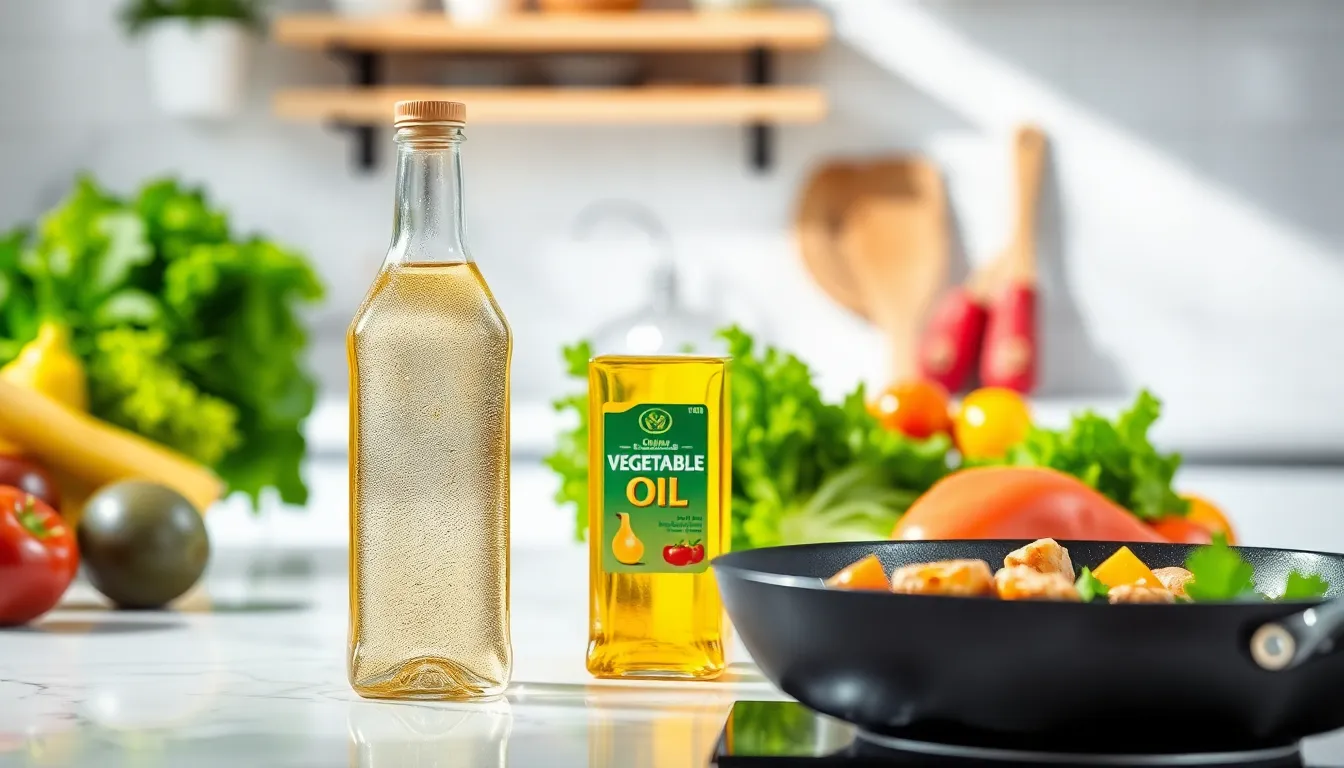Frying is a popular cooking method that brings out the rich flavors and textures of food. Among the many options available, vegetable oil often stands out as a go-to choice for home cooks and professional chefs alike. But is vegetable oil really the best option for frying? Understanding its properties can help in making informed decisions in the kitchen.
With its high smoke point and neutral flavor, vegetable oil is versatile for various frying techniques, from deep frying to sautéing. However, health considerations and cooking performance play crucial roles in determining whether it’s the right fit for every dish. Exploring these aspects will shed light on whether vegetable oil deserves a place in your frying routine.
Table of Contents
ToggleUnderstanding Vegetable Oil
Vegetable oil plays a significant role in frying due to its favorable properties. It exists in various forms, each offering unique benefits and limitations for cooking.
Types of Vegetable Oils
- Soybean Oil: Common in many kitchens, it’s an inexpensive option with a high smoke point of about 450°F (232°C). It’s suitable for deep frying and sautéing.
- Canola Oil: Known for its light flavor and high smoke point of 400°F (204°C), canola oil is rich in omega-3 fatty acids, making it a healthy choice.
- Corn Oil: With a smoke point of approximately 450°F (232°C), corn oil works well for frying. It contains antioxidants, which may provide some health benefits.
- Sunflower Oil: This oil has a high smoke point of around 440°F (227°C) and is praised for its light taste, making it ideal for frying and baking.
- Peanut Oil: Popular in Asian cuisine, peanut oil has a smoke point of about 450°F (232°C). Its nutty flavor enhances dishes, especially fried ones.
- Safflower Oil: Similar to sunflower oil, safflower oil has a smoke point of around 450°F (232°C) and is favored for its neutral taste in frying.
Nutritional Profile of Vegetable Oil
Vegetable oils generally provide a mix of fats, primarily unsaturated fats beneficial for heart health. They are low in saturated fats, with some oils like canola containing omega-3 and omega-6 fatty acids.
| Type of Vegetable Oil | Saturated Fat (g per 100g) | Monounsaturated Fat (g per 100g) | Polyunsaturated Fat (g per 100g) |
|---|---|---|---|
| Soybean Oil | 15 | 23 | 58 |
| Canola Oil | 7 | 63 | 28 |
| Corn Oil | 13 | 28 | 59 |
| Sunflower Oil | 10 | 20 | 66 |
| Peanut Oil | 17 | 50 | 32 |
| Safflower Oil | 10 | 75 | 14 |
Moderate use of vegetable oil can aid in a balanced diet. However, excessive consumption might lead to an increase in omega-6 fatty acids, potentially negatively affecting health.
Benefits of Using Vegetable Oil for Frying

Vegetable oil offers several advantages that make it a popular choice for frying. Its characteristics contribute to effective cooking and enhance the overall quality of fried foods.
High Smoke Point
High smoke points characterize many vegetable oils. For instance, canola oil has a smoke point of about 400°F (204°C), while peanut oil reaches approximately 450°F (232°C). These high temperatures prevent the oil from breaking down during frying, which helps retain the flavor integrity of the food. Additionally, avoiding smoke production minimizes harmful compounds, creating a safer cooking environment.
Versatility in Cooking
Versatility defines vegetable oil’s role in various cooking methods. It suits multiple frying techniques, from deep frying to pan frying. The neutral flavor complements a wide range of dishes without overpowering them. Furthermore, different vegetable oils cater to specific culinary applications; for example, sunflower oil enhances the taste of light, crispy foods, while olive oil adds richness to Mediterranean recipes. This flexibility allows cooks to explore various flavor profiles while maintaining a focus on health.
Potential Concerns with Vegetable Oil
Several concerns exist regarding the use of vegetable oil for frying, particularly involving health implications and environmental impact.
Health Implications
Health implications arise from the high omega-6 fatty acid content typically found in vegetable oils. While omega-6 fatty acids are essential for the body, excessive intake may lead to inflammation and various health issues. Studies suggest that diets high in omega-6 to omega-3 ratios can contribute to chronic diseases, including heart disease and certain cancers. It’s crucial to balance the intake of vegetable oils with omega-3 fatty acids, which are found in sources like fish, flaxseeds, and walnuts.
Trans fats, which can form during the high-heat frying process, also pose additional health risks. Although most vegetable oils contain negligible trans fats, improper frying practices may increase their presence, leading to negative cardiovascular effects. Monitoring cooking temperatures can mitigate this risk and maintain the oil’s healthful properties.
Environmental Impact
Environmental impact concerns relate to the production of vegetable oils, particularly in relation to deforestation and biodiversity loss. Palm oil, for example, is associated with significant environmental degradation due to land clearing practices in tropical regions. This leads to habitat destruction for endangered species and contributes to climate change.
Sustainable practices in vegetable oil production, such as certified sustainable palm oil, can help reduce these environmental impacts. Consumers may choose products labeled as sustainable to support eco-friendly practices. Awareness of these issues encourages informed decisions regarding the selection and use of vegetable oils in cooking.
Comparisons with Other Oils
Understanding how vegetable oil compares to other oils aids in selecting the right option for frying. Each oil incorporates distinct properties, affecting flavor, health benefits, and cooking performance.
Olive Oil
Olive oil, particularly extra virgin, has a lower smoke point, typically around 375°F (190°C). This property limits its use for high-heat frying. Its robust flavor enhances Mediterranean dishes, making it suitable for sautéing and light frying. Rich in monounsaturated fats, olive oil offers health benefits, including antioxidant properties. However, for frying techniques requiring high temperatures, vegetable oil often provides a more stable option.
Canola Oil
Canola oil features a higher smoke point of approximately 400°F (204°C), making it versatile for frying. This oil has a neutral flavor profile, allowing it to complement an array of dishes without overshadowing their taste. Canola oil ranks low in saturated fat and high in omega-3 fatty acids, promoting heart health. While it’s a suitable alternative for frying, it lacks some of the flavor complexities found in oils like olive oil.
Coconut Oil
Coconut oil possesses a smoke point around 350°F (177°C), suitable for medium-heat frying. Its distinct flavor infuses dishes with a subtle sweetness, particularly in Asian and tropical cuisines. Coconut oil consists primarily of saturated fats, which can raise cholesterol levels if consumed excessively. Despite this, its medium-chain triglycerides are metabolized differently, offering unique health benefits. Vegetable oil provides a higher smoke point and greater versatility for frying, making it more favorable for various cooking techniques.
Choosing vegetable oil for frying can be a smart decision for home cooks and chefs alike. Its high smoke point and neutral flavor make it an excellent option for various frying techniques. While it offers health benefits through unsaturated fats, moderation is key to avoiding potential issues with omega-6 fatty acids.
Being mindful of the environmental impact of vegetable oil production is also essential. Opting for sustainably sourced oils can help support eco-friendly practices. By considering both health and environmental factors, individuals can make informed choices that enhance their cooking while promoting overall well-being.



